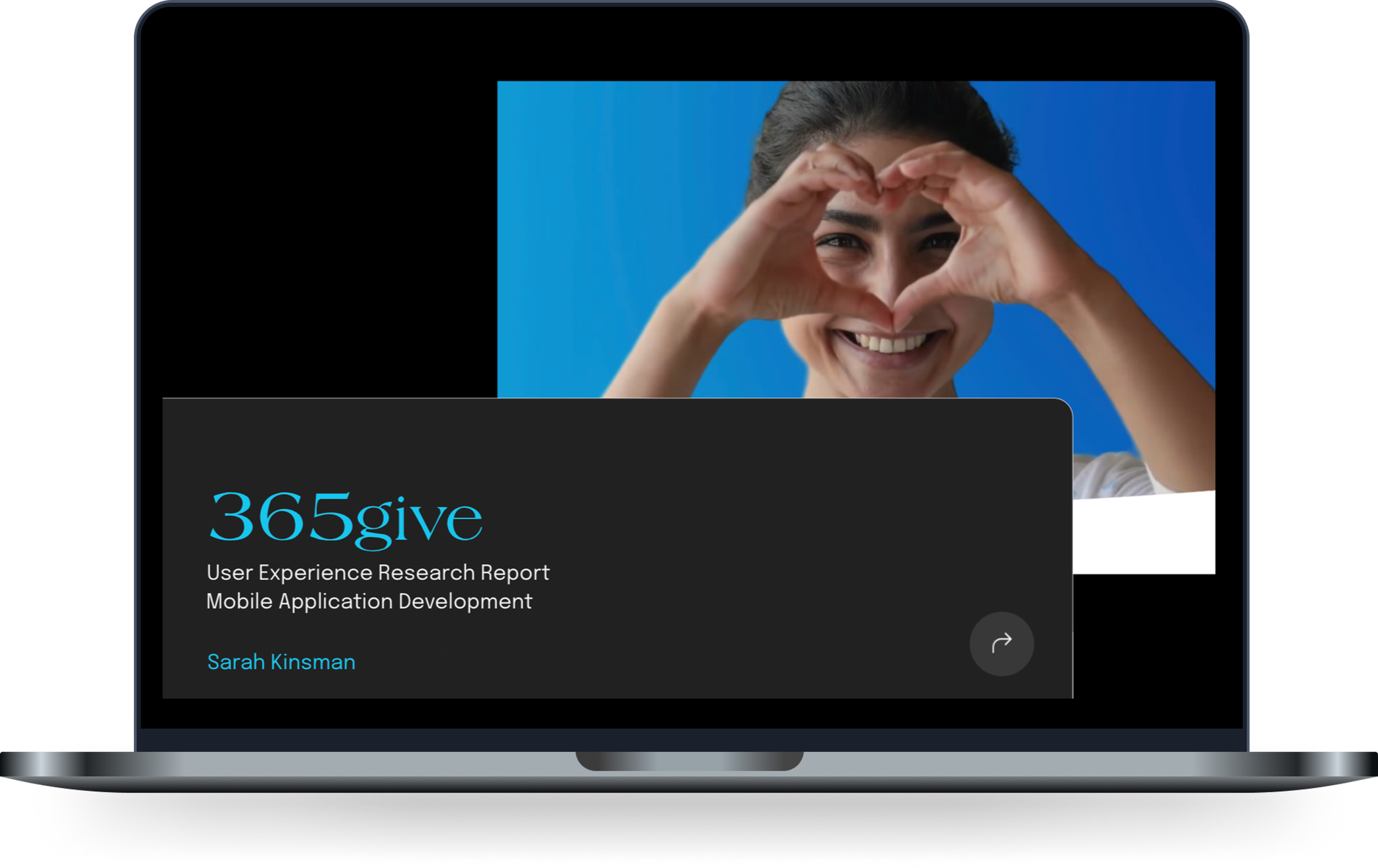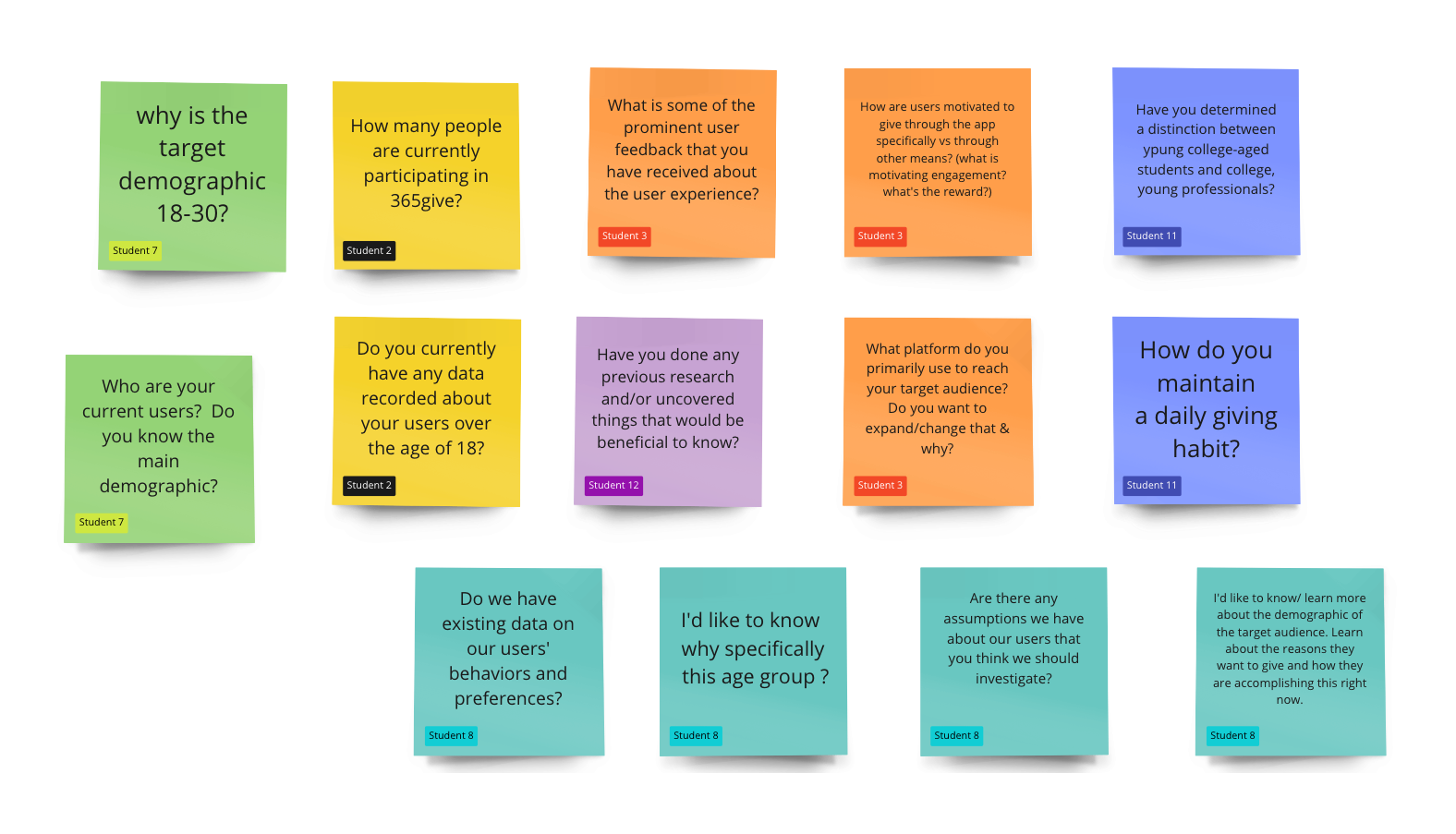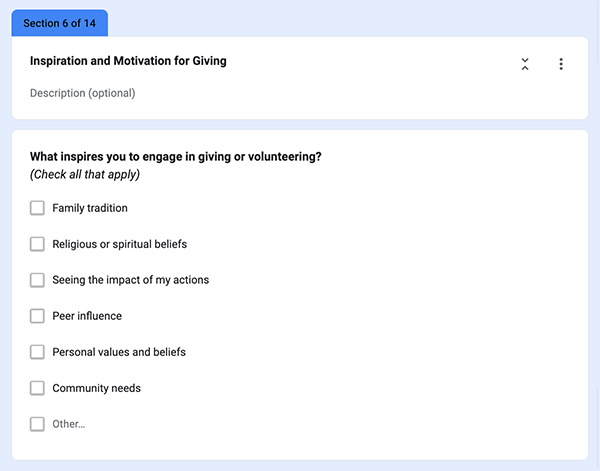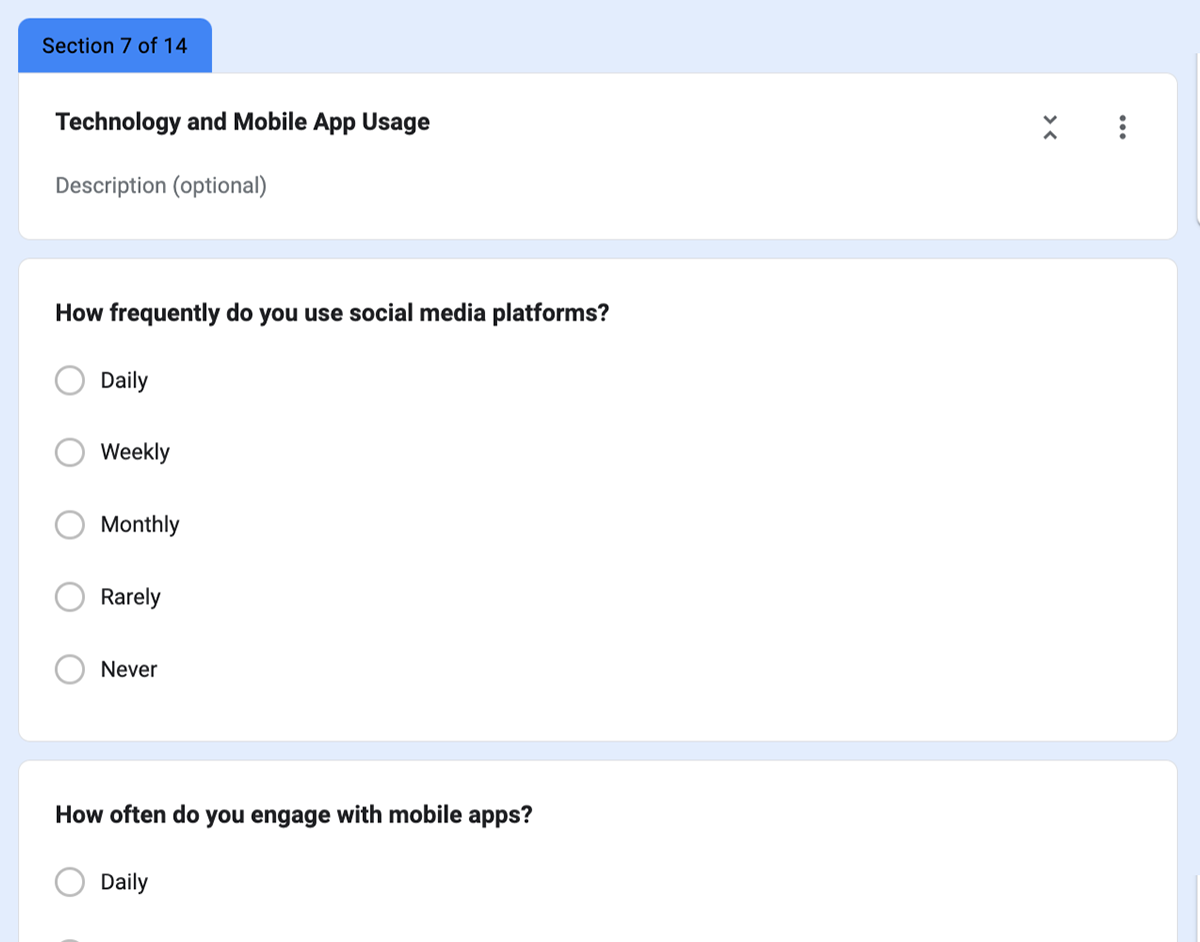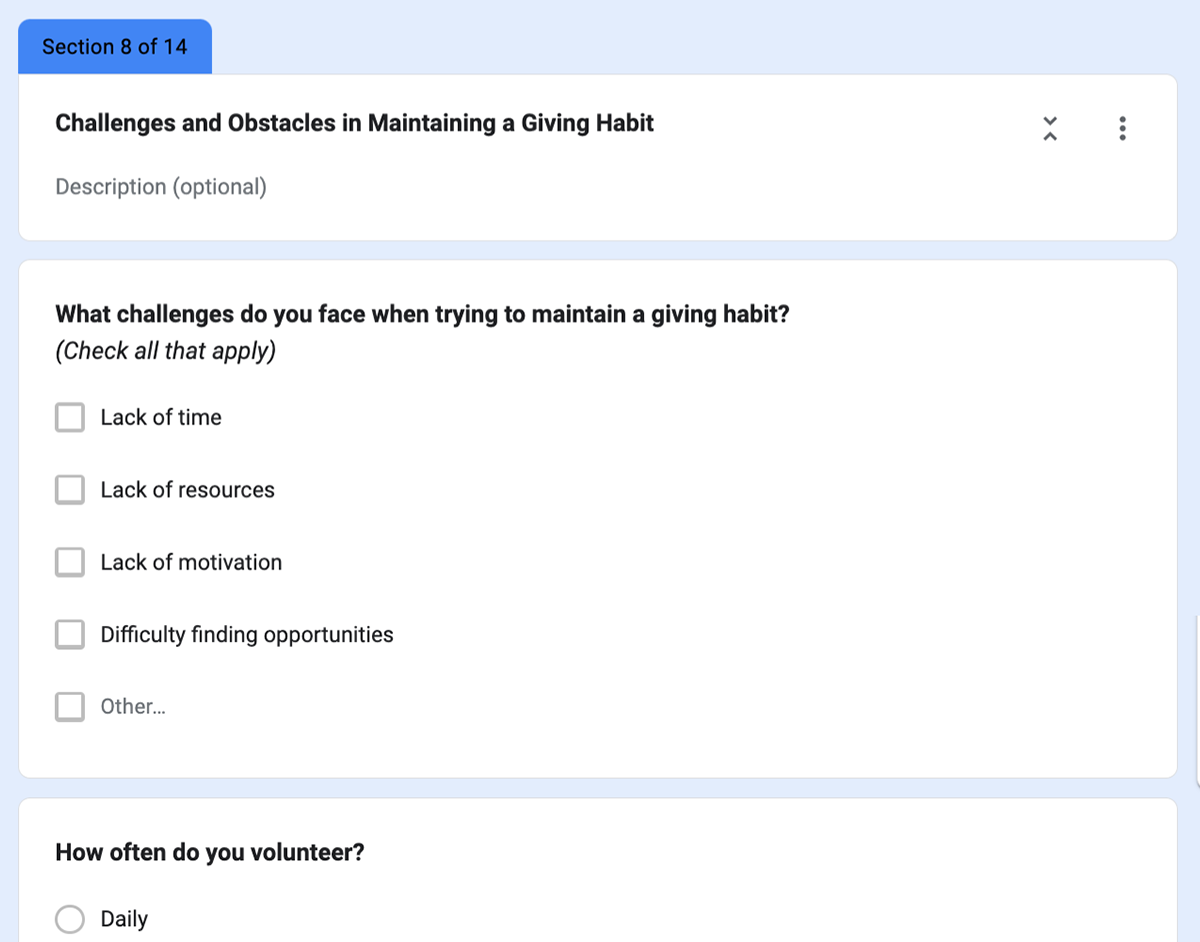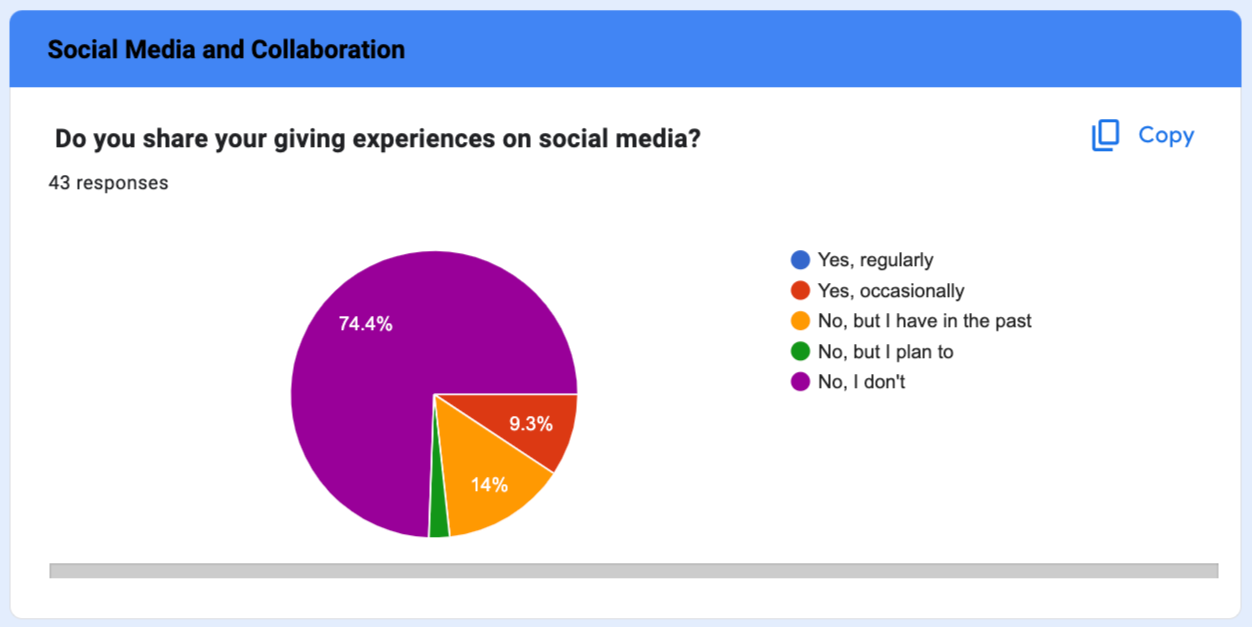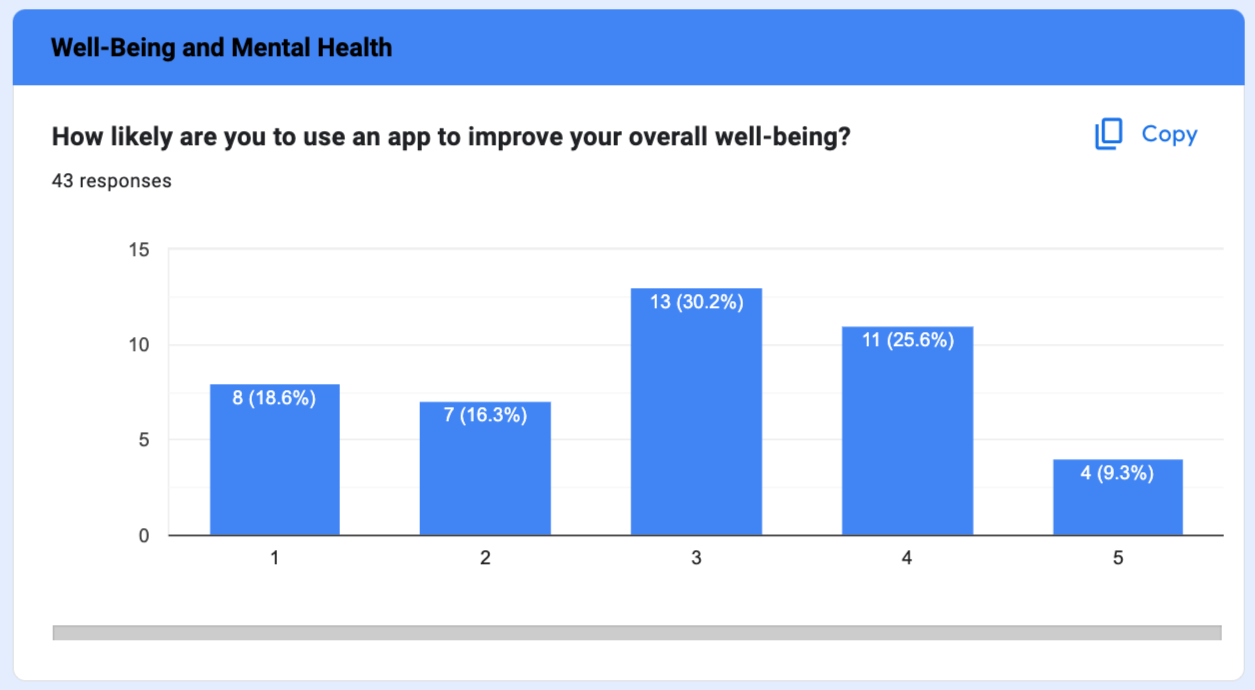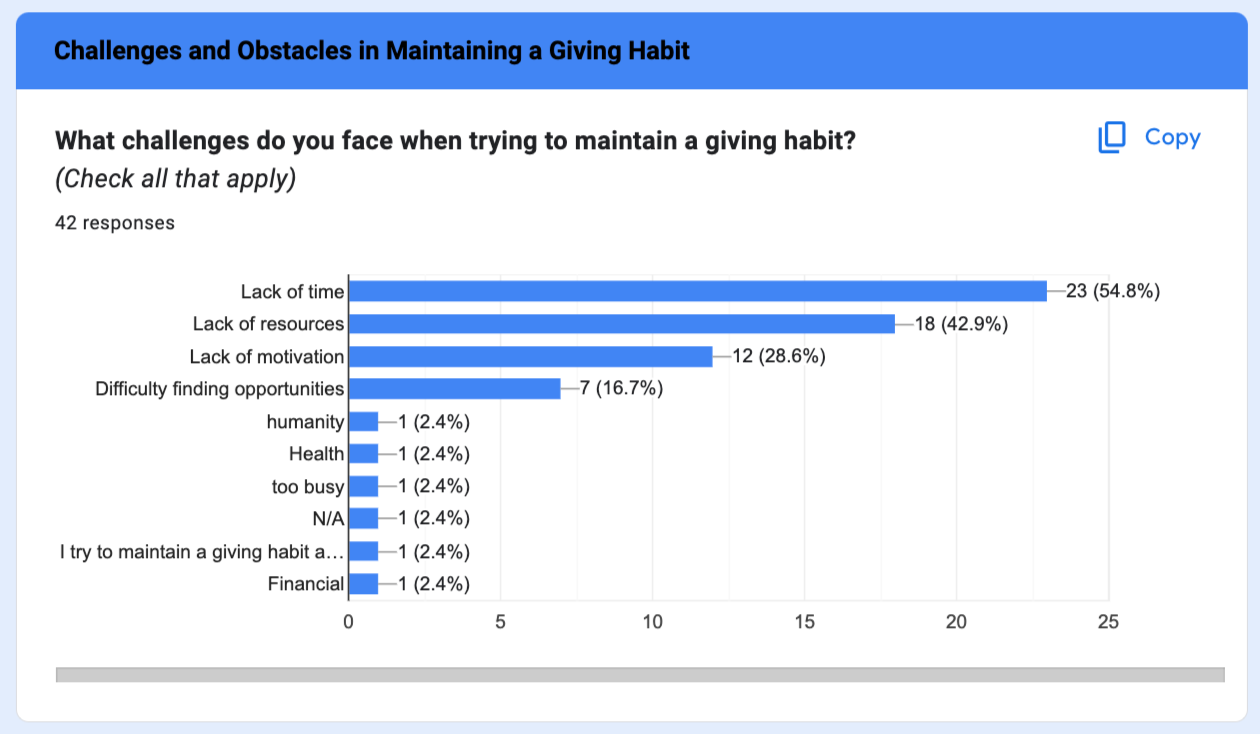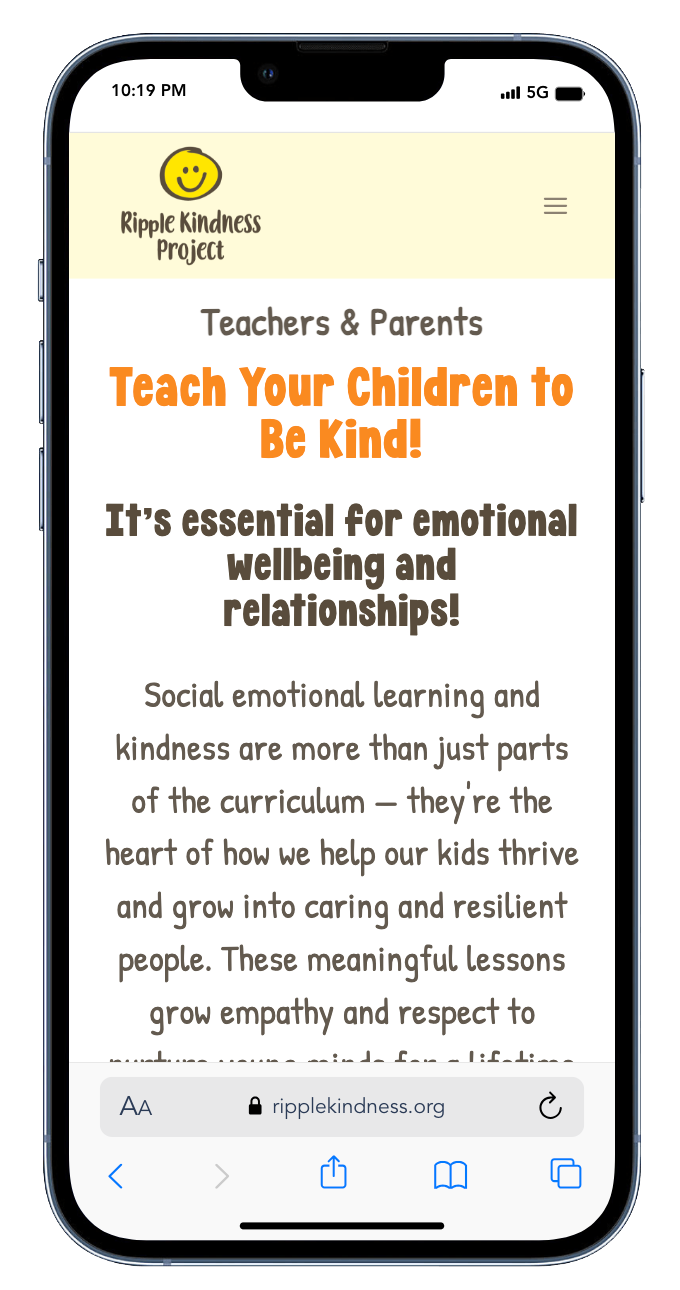365give
User Research For App Design
March-June 2024
365give is a global initiative that inspires individuals of all ages to engage in daily acts of kindness, compassion, and generosity. Research objectives …
Develop a mobile application and define the user
Target people aged 18 to 30 years old
Enhance their engagement in volunteering and giving activities.
Target audience's perspectives, needs, and motivations related to giving, happiness, and daily habit formation.
Align with 365give's goals and provide a meaningful and engaging user experience.
Limitations…
Since the app was not yet designed and only the website was available, I was unable to conduct usability testing. To mitigate this limitation, I gathered valuable insights from alternative sources, including competitor analysis, a comparative review of similar apps with desired features for 365give, and desktop research. Additional limitations included constraints related to the number and diversity of participants, the prevalence of habit-tracking app users, the scope of educational content provided by the 365give staff, and the lack of access to other educational platforms for testing functionality.
What I discovered and how it affected the report
-
The number of participants who used habit-tracking apps was significantly lower than those who did not. Many respondents expressed limited interest in habit-tracking apps or social features, despite their survey responses suggesting otherwise. However, one participant reported using the Flo app for habit tracking on a daily basis.
-
A larger pool of teachers and administrators would have provided deeper insights into things to incorporate or to avoid in the app design. Educators are hesitant to adopt beyond what the choose for curriculum, and are leery of mandates.
-
A contact list generated from the user survey, which included 43 respondents, was used to send invitations to those who opted in at the end of the survey.
A larger participant pool and extended data collection period could have provided more comprehensive data and a greater diversity of insights.
-
Although the 365give website mentions that educators are part of the team responsible for developing content, it does not provide details on the content development process or whether K-12 educators are involved in this process.
For optimal adoption of content and materials in classrooms, it is essential that the development process is fully transparent, including information about who is involved and how the materials are created.
-
Upon reviewing the analytics provided by 365give, it was noted that Schoology is identified as one of the organization’s competitors.
The Schoology app features distinct settings for parents, students, and educators. However, I currently lack access to information on how Schoology integrates learning materials from 365give or how users can directly access the 365give website through Schoology.
Overview…
At the heart of 365give is the belief that even small acts of giving can create a significant impact, not only on those receiving help, but on the givers themselves. The worldwide reach of the organization, and the innovation of technology, prompted 365give to request user experience research to obtain insights that would contribute to the organization’s development and success of a mobile app.
What was learned and methods I used
-
User surveys and interviews revealed that the majority of participants engage in volunteering and intentional acts of kindness at varying levels.
Most users turn off app notifications because they find them too frequent, do not value the content, or did not select them.
App usage varied depending on several factors, including age, type of employment, age of children, time constraints, interest in app content, location, sharing capabilities, overall user experience, and whether the usage was voluntary.
-
Survey building and design
Quantitative data derived from user surveys
Qualitative insights from user interviews
Competitive and comparative analysis
Literature and desktop research
-
Conducted a stakeholder interview with Jacqueline Way, founder of 365give.
Designed a user survey and received 43 responses.
Conducted user interviews and reported on the results.
Completed competitive and comparative analysis.
Provided recommendations and solutions to 365give for the design of their app
Research Process…
To understand the needs and pain points of 365give’s target audience concerning volunteering and giving, I began with affinity mapping to organize themes and develop questions I would use when conducting a stakeholder interview with Jacqueline Way, the organization’s founder and Chief Happiness Officer. From this interview, I identified the need to explore motivations, preferences, and factors affecting engagement with habit-tracking apps. Additionally, I aimed to pinpoint limitations and potential pitfalls to support the development of an app that aligns with 365give’s goals, ensuring a meaningful and engaging user experience.
The types of research I conducted
-
I designed a detailed survey to collect both qualitative and quantitative data. This survey was structured to capture in-depth responses and measurable insights.
I then distributed the survey via Google Forms and email to a targeted group of participants, ensuring broad reach and comprehensive data collection.
-
I conducted in-depth interviews with participants both via Zoom and in person to gather comprehensive insights and diverse perspectives.
These interviews were designed to explore user experiences, identify key pain points, and understand their motivations in detail, thereby providing a richer understanding of their needs and preferences.
-
I conducted a comprehensive review that included competitor websites and social media channels, as well as potential competitor apps and existing habit-tracking apps. This also involved analyzing case studies and articles related to habit tracking, along with examining 365give’s website analytics.
This multifaceted approach provided a thorough understanding of the competitive landscape, user behaviors, and industry trends.
-
User interviews highlighted several favored apps, prompting a thorough exploration of these apps and their features.
This involved analyzing their functionality, design elements, and user engagement strategies to understand what made them successful and how their features might inform the development of our own app.
Giving Habits
What are people’s giving habits and the frequency they engage in such activities?
How does giving correlate with personal happiness for individuals?
What factors inspire and motivate people to volunteer, donate, or perform acts of kindness?
App Usage and Habit Tracking
What features enhance engagement and user-friendliness of apps?
What motivates individuals to share their personal experiences on social media?
What is the extent of interest in habit tracking, and how does it vary across different user demographics?
Pain Points
What factors could potentially discourage or prevent someone from using an app?
Are there any potential constraints or limitations we should be aware of?
What are the common challenges or frustrations users frequently encounter with apps?
Survey Design…
I employed affinity mapping to organize and synthesize data from my research sessions and the stakeholder meeting. Using sticky notes on a Miro board, I categorized similar ideas, insights, and observations into thematic clusters, which illuminated key patterns and relationships. This visual organization enabled me to identify overarching themes and critical insighcs, guiding the subsequent steps and strategic decisions. I then utilized Miro's cluster feature and ChatGPT to develop and refine themes, and subsequently polished the survey questions in Google Docs.
User Surveys…
The survey used a short-format research method, taking into account that if the survey was too long it would run the risk of participant fatigue and low response rate. To ensure clarity, the language used was straightforward and accessible, with common terms and explanations provided where necessary. The survey began with general questions and gradually transitioned to more specific ones. I took care to avoid leading questions and implemented conditional responses to gather additional input when needed.
How I built the survey and who participated
-
Open-ended
Multiple response
Multiple choice
Likert Scale
Demographic
Short answer
-
The survey comprised fourteen sections, covering a diverse range of topics, including:
Demographics and personal information
Inspiration and Motivation for Giving
Technology and Mobile App Usage
ChallengesObstacles in Maintaining a Giving Habit
Social Media and Collaboration
-
Participants were recruited from both personal and professional networks, resulting in a total of 43 respondents. Many of these individuals also agreed to participate in follow-up user interviews after completing the survey.
Survey Results…
A survey was conducted to obtain quantitative insights into respondents' attitudes, behaviors, and preferences related to mobile applications, overall well-being, and habit tracking. The survey, consisting of 59 questions, was created using Google Forms and distributed via a link embedded in personalized emails. It included a range of question types, such as multiple choice, checkboxes, linear scales, short answers, and conditional logic. Results were captured in summary format, by question, and by individual respondent.
Survey results broken down by question
-
Ages ranged from 18-65+ with the highest number in the 25-34 category
25.6% have children under the age of 18
Occupations included full and part time professionals, students, educators, homemakers, and retirees
-
When asked if their workplace or organization had more collaborative activities for team development 41.7% of Professionals said yes, while the rest responded with being unsure, not at this time or that it was not applicable
When asked the same question, Educators and Students were split evenly in half of yes they would and not they wouldn't
-
Respondents were mixed in the kinds of volunteering they do and how often, 41.9% said that they do not participate in community service or volunteer work, 27.9% said they do occasionally, 14% said they plan to and less than 14% said they do not, or they do regularly
Activities ranged from environmental cleanups, to community based outreach, animal welfare, education, gardening and formal programs
1/3 of respondents had participated in charitable giving in the last 6 months, 1/3 in the last month, while for others it had been in the last year or more, or never:
-
Many expressed interest in future participation in random acts of kindness, volunteering, monetary donations, community service or advocacy
Interest in a wide range of social causes was expressed and included human rights across a number of categories, environmental sustainability, animal welfare, and addressing food insecurity at the top of the list
-
Personal values and beliefs ranked highest in this category with 88.4% of respondents choosing this as their top motivation
Personal experience (93%) and family and friends (74.4%) were top for inspiration, and 76.7% felt that helping others was important
Only 30.2% felt that they were more likely to maintain a giving habit if they received an award or notification
-
86% said that they use social platforms daily, the remaining 14% was split with weekly, rarely and never
93% said they engage with mobile apps dail
58.1% said they do not use apps to track habits, while 32.6%s said they do occasionally and 9.3% said they do daily
The majority of people remain neutral on using a mobile app to track habits or to track and share giving activities
46.5% said that they engage in mental health practices like yoga, meditation techniques, mindfulness and positive thinking
-
Lack of time, motivation, and resources, as well as difficulty finding opportunities ranked highest
The majority of respondents was split between rarely and never volunteering
-
74% said they do not share their collaboration activities on social media
Platforms that are used most for social are Instagram, Facebook, TikTok, LinkedIn and Snapchat
Platforms most used for collaboration are Slack, Teams, Google Meet, Mattermost, Discord, GroupMe and text messaging
Only 4.7% feel comfortable sharing their giving experiences on social
Only 7% collaborate with their peers in activities and tasks, but 20.9% said they felt it enhances their work
The biggest challenges in collaborating are different working styles, conflicting schedules and miscommunication, yet 41.9% said their motivation and engagement increases significantly when collaborating
-
The majority of respondents agreed that giving makes them feel happier, and fulfilled after they have done a good deed
The majority of respondents feel like they have an impact on others
-
65.1% felt neutral or leaned towards using an app for improving overall well-being
The majority said they would not like to be more in touch with the way they feel while about 27.9% felt they would
44% do not use apps for emotional or mental well-being, while 34.9% said they have tried a few but don't stick to them
The top things identified for apps keeping people engaged were feeling like a task was accomplished, a sense of community, and daily reminders. Incentives were also a draw
User Interviews…
Semi-structured interviews were conducted between late April and mid-May 2024, both via video calls and in person, to gather qualitative insights into user experiences and preferences. The primary objectives were to:
Understand the factors influencing the selection and engagement with habit-tracking apps, including reasons for use or non-use.
Examine the various types of volunteering and charitable activities in which users are actively engaged.
Investigate social media preferences, including the types of content users are inspired to share or avoid sharing, and the reasons behind these choices.
Analyze the relationships between giving, acts of kindness, and their impacts on emotional and mental well-being.
Who was recruited and how
-
A total of 43 responses were received for the User Survey. Included in the survey was a request for permission to contact respondents for follow-up interviews, and many agreed to participate.
-
Formal and personalized email invitations were sent to the survey respondents, inviting them to voluntarily participate in a 30–45 minute interview. Scheduling was arranged according to their availability.
Personas…
Personas were created using criteria outlined in the project brief, which focused on the target audience of individuals aged 35 and older. This development process was informed by comprehensive data collected from User Surveys and User Interviews.
Olivia - Professionally Employed
Olivia uses apps and technology in her daily work, and on her free time enjoys simplicity - She isn't online as much in her down time. She is often moving at a fast pace keeping up with deadlines, and is often on video calls. She is tech savvy and on social platforms daily as part of her job. She loves volunteering, but really needs the motivation to get there.
Gina and Megan - Educators
Classwork used to be all done by hand with pencil, paper and crayons. Now classrooms have iPads, Chromebooks and apps like Schoology which tracks students progress, shows parents grades, organizes lessons and homework. They prefer to focus on the established curriculum as mandated by each state. Do not volunteer often due to schedules and time constraints.
Emily - Parent
Emily has two full time jobs, her day job, and being a parent to her child under the age of 18. She is on the go from sunrise to sunset every day and has to keep track of everything. Apps are key to her schedules, and for her mental and physical well-being. She likes to volunteer at her child's school, and in soup kitchens, and in community events.
Competitive Analysis…
In terms of web traffic and engagement, 365give ranks lower than three others for total site visits, but remains competitive in device distribution. It performs similarly to Random Acts of Kindness and Ripple Kindness in desktop and mobile site visits. Other key competitors identified by 365give’s analytics include Good Deeds Day and Life Vest Inside. None appear to offer apps.
Comparative Analysis…
I conducted a comprehensive comparative analysis of various apps, focusing on the features requested by Jacqueline and incorporating insights from user interviews. This analysis provided detailed information on critical aspects such as habit tracking capabilities, privacy settings, and game-based learning approaches. The findings offer valuable guidance for designing the 365give app, ensuring that it incorporates effective and relevant features.
Apps that I found with ideal features for 365give
-
Features that align with 365give's app goals:
Inclusivity
Personalized to the user
Choose how often you receive notifications, and the kind
Mental health features that help track moods and feelings
Personalized insights and recommendations
Users can view their history, patterns, and trends over time
Offers a community feature where users can connect with others, share experiences in a supportive environment.
Privacy settings to keep a user's information secure
-
Features that align with 365give's app goals:
Interactive lessons covering a variety of learning topics
Gamified activities, quizzes, and exercises
Approach emphasizes personalized learning and adaptive feedback
Spaced repetition to help users progress at their own pace
Users can choose what they want to learn, and how often
Fun, accessible, and effective for users of all ages and proficiency levels
Interactive, text-based stories in various languages that help learners
A version is tailored for classroom use, allowing teachers to monitor student progress and assign exercises
Privacy settings to keep a user's information secure
-
Features that align with 365give's app goals:
Offers variety of sessions ranging from short exercises to longer ones
Users can personalize their meditation experience by selecting sessions based on their preferences, goals, and available time
Offers programs specifically designed for different age groups, including adults, teenagers, children, and educators
Allows users to track habits and progress over time
Offers a range of activities and exercises that can be incorporated into daily routines
Privacy settings to keep a user's information secure
Desktop Research…
The following case studies offer great insight into how two well-known brands shifted their content presentation and formatting to grow online follows and encouraging additional use of their products. I provided this to 365give in addition to my findings from Competitive Analysis.
Netflix - Shift In Content Strategy
Netflix's shift from being solely a platform for hosting content to producing its own original series and movies lead to a significant growth in subscribers and revenue.
Instagram - Rise In Visual Content
Instagram’s model of continuously enhancing its photo and video features, lead to its success in attracting millions of users and becoming a key player in the social media landscape.
Synthesis…
After synthesizing insights, data, and observations from various research activities, I created a cohesive understanding of user needs, behaviors, and pain points. By distilling complex and fragmented information, I generated actionable insights that inform design decisions. Alongside providing an executive summary, I transformed raw research data into meaningful insights that will drive effective, user-centered design solutions.
Areas I identified next steps for
-
Key features to pattern
Gamification style
Bite sized content
Inclusive to all genders
Good news stories
Set your own pace
Customize learning content
Notification settings 100% in the user's control
Habit tracking optional
-
Mandate concern
Recommend a larger survey with K-12 educators, not solely school administrators, to understand the connection to Schoology.
Educators cautioned against collaboration tools between classrooms as many can find this frustrating if it becomes a mandate.
-
Customize to the user
Comparative analysis and user interviews showed a love for personalization. App users also loved notifications that aren't task based, but mood lifting things like, "good news" of the day, or simply things that make someone smile. Sound optional is also key.
-
Not for everyone:
Those interviewed shared that they are either not on social much, or choose not to share their good deeds online. Views expressed were that they were doing good deeds to help others, share the wealth, and not for recognition or to gain likes and follows.
